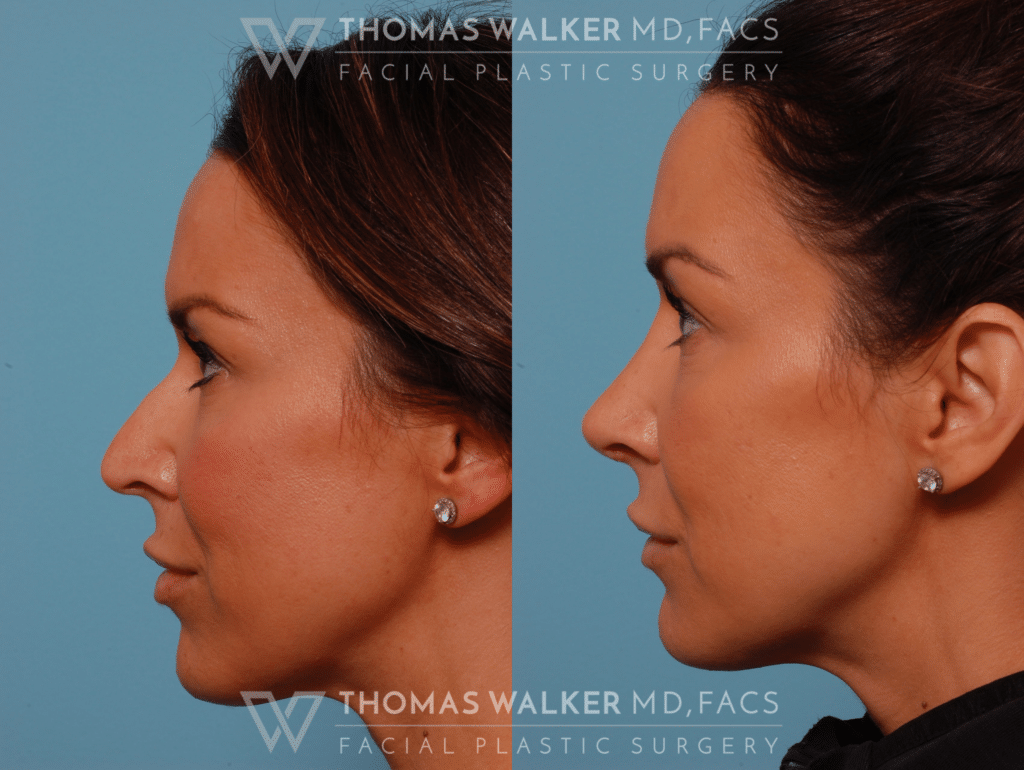
Rhinoplasty
When you think of a beautiful face, you probably think of harmony and balance between all facial features. Because the nose is at the center of the face, it mustn’t distract from the rest of your features. Suppose you are unhappy with the appearance of your nose and wish to improve the aesthetic features of your overall facial appearance. In that case, a cosmetic rhinoplasty may be a good option for you. Having a specialist perform your rhinoplasty is paramount and the best way to ensure natural-looking, beautiful results while improving or at least maintaining your nasal bones and breathing.
Form and function go hand-in-hand, which is especially true in nasal surgery. Dr. Walker is a leading expert in primary and complicated revision nasal surgeries, whether the concerns are aesthetic or are caused by functional issues such as a deviated nasal septum. Clients who travel domestically and internationally seek out his signature Atlanta Rhinoplasty to address concerns about bone and cartilage. WalkerMD Facial Plastic Surgery is located 19 minutes from Downtown Atlanta and 12 minutes from Brookhaven.
WHAT IS RHINOPLASTY?
A rhinoplasty, also referred to as “nose job”, is a cosmetic procedure done to reshape your nose to enhance your facial harmony while optimizing nasal airflow. This procedure is very popular and is performed on clients of a wide age range starting as young as a teenager. Rhinoplasty can address many nasal problems, including:
- Size of the nose.
- Dorsal hump, nasal bridge height, and width.
- Crooked nose.
- Bulbous tip.
- Nasal tip size, rotation, and projection.
- Nostril size, width, and shape.
- Amorphous nasal shape.
- Alar-columellar relationship.
- Nasal asymmetry.
- Nasal obstruction.
As part of rhinoplasty, Dr. Walker corrects a deviated septum, if present, in which the nasal septum is crooked or off-center, contributing to difficulty breathing. Nasal valve collapse correction, inferior turbinate reduction, and septal perforation repair are commonly performed with a rhinoplasty. Dr. Walker can adjust any nasal structure to produce proper alignment for easier breathing, which often leads to decreased snoring, increased exercise tolerance, less frequent dry throats, and improved quality of life.
-
Who is a Good Candidate for Rhinoplasty?
Individuals unhappy with their nose’s shape and/or size can often benefit from rhinoplasty surgery. Healthy individuals with realistic expectations for the outcome of their procedure are often happiest with their results. Men and women alike seek out Dr. Walker’s Atlanta Rhinoplasty. Traditionally, age 16 and above is considered the minimum age for rhinoplasty. However, a rhinoplasty may be performed in patients as young as 14 years of age in select cases, depending on the patient’s level of maturity and whether or not he or she has gone through puberty with a growth spurt.
Facial growth and maturity must be completed before considering a rhinoplasty, which Dr. Walker will address during your consultation. If you find yourself frustrated with the appearance or breathing of your nose and have distinct issues you hope to improve, enhance, or correct, a nose job procedure may be the right course of action. Realistic expectations must be discussed as your nose and facial profile will be altered.
Dr. Walker will take ample time to listen to your concerns and goals during your consultation, take photos of your nose from various angles, and use computer imaging software to show suggested results, taking your wishes into account and what can be achieved. Dr. Walker is not trying to “sell” a surgery based on idealized computer imaging that cannot be realistically achieved but rather views computer imaging as a helpful tool in communication in an attempt to portray a realistic outcome. The best way to determine if rhinoplasty is right for you is through a consultation appointment with Dr. Walker.
Ideal Candidates for Rhinoplasty
Patients must realize that the nose changes over a lifetime and that there is a small possibility that a minor “touch-up” procedure might be required at some point after surgery, although rare.
Even though patients who had no prior nasal surgeries or trauma are the best candidates, patients who had prior nasal surgeries or trauma may still be good candidates for secondary or revision rhinoplasty as long as general health allows for general anesthesia.
Common reasons for rhinoplasty include a crooked nose, dorsal hump, bulbous tip, amorphous shape, and poor nasal breathing.
-
How is the Rhinoplasty Procedure Done?
Rhinoplasty is done under general anesthesia as an outpatient procedure. Two main rhinoplasty approaches are used today: external/open rhinoplasty and endonasal/closed rhinoplasty (see FAQs below). During an open rhinoplasty, a tiny external incision will be made at the bottom of your nose between the nostrils, which will become invisible. In a closed rhinoplasty, all incisions are hidden inside of your nose. Each technique has its pros and cons, and Dr. Walker can help determine which technique is most suited for you.
Dr. Walker will then reshape the nose structure as needed and, if necessary, correct a deviated septum. He utilizes various cartilage grafting techniques to reshape your nose for permanent aesthetic and functional improvements.
Rhinoplasty Recovery
The surgery is performed on an outpatient basis, meaning that you will go home on the day of your surgery under the care of a responsible adult family member or friend. The recovery from rhinoplasty occurs in various stages. From that perspective, rhinoplasty is somewhat different from other facial surgeries. There is an initial 1- to 2-week period during which the bruising (if present) subsides, and the nasal external and internal swelling improves for improved airflow. The nasal cast and sutures will be removed one week after your procedure; at this point, you can let water run over your nose again when washing your hair. Most patients experience some discomfort for the first couple of days that most patients can control with Tylenol. However, a small amount of pain medication is prescribed to you if you experience discomfort. You are encouraged to rest during the first week and to adhere to Dr. Walker’s thorough post-operative instructions, including a low-sodium diet, avoidance of strenuous activities, no nose-blowing, no straining with bowel movements, and avoidance of coughing if possible.
This is followed by a 4- to 6-week period of continued swelling resolution during which strenuous activities and salt/sodium intake are discouraged. The post-surgical period is almost over, and the detailed post-operative results are starting to become more apparent. There is still residual swelling on the nose, and this will change from day to day. Some days, the nose will look better than others as the swelling continues to go up and down. Although the swelling completely subsides after about a month, the secondary healing stage will start with skin contracture of the nose and continued nasal refinement, taking on the shape of the underlying framework, which takes multiple months. The residual swelling is starting to decrease from top to bottom. The top of the nose (bridge) is looking more refined. Strenuous activities may be resumed after 4-6 weeks.
By the 3 months mark at the latest, you have gotten used to the new facial aesthetic that your rhinoplasty has given you. Generally, most visible changes will have occurred by the three-month mark, although it takes a full year or so for the final nasal shape to be present. Most clients no longer feel subconscious about their nose after 4-6 weeks and are ready for wedding photos to be taken after about 2-3 months. The nose tip is usually the last area to completely “heal.” This area may still have a small amount of fullness after 3-6 months. Dr. Walker will closely monitor your healing throughout the recovery process with regular follow-up visits.
You can enjoy full final results after about one year with essentially invisible incisions.
Why Choose Dr. Walker for Your Rhinoplasty?
Rhinoplasty and revision rhinoplasty are regarded as the most complex and delicate surgeries in cosmetic surgery. It takes a certain character and attention to detail of a surgeon with technical skills to master this operation consistently well. Expertise in rhinoplasty requires training, experience, anatomical knowledge, and excellent technical skills. Having trained under one of the most renowned nose experts in the world, Dr. Dean Toriumi, in Chicago, Dr. Walker is widely recognized as one of the finest rhinoplasty surgeons in the Southeastern United States and the entire nation. Many of Dr. Walker’s patients travel across state lines and internationally from overseas to seek Dr. Walker’s rhinoplasty expertise. He has exceptional qualifications and has based his career upon delivering consistently excellent results in primary and very complex tertiary rhinoplasty surgeries. He is known for individualizing his surgical plans for every patient and artistry in the operating room. He will spend as much time as needed to deliver the best possible result to every patient. From the initial consultation to the surgical procedure, Dr. Walker is devoted to giving as much time as is necessary to meet and hopefully exceed all of his patients’ expectations. He follows his patients long-term (months to years) to ensure they achieve the best possible long-term outcome. Although rarely necessary, an early in-office intervention such as steroid injections, needle shave, or other small interventions can prevent the need for revision surgery down the line.
Schedule Your Consultation
If you would like to learn more about the best rhinoplasty Atlanta has to offer and how it can benefit you, contact our Atlanta office today! Our team will be happy to schedule your consultation appointment with Dr. Walker. This is your first step on your cosmetic procedure journey, during which you will discuss your individual rhinoplasty goals with Dr. Walker. He will then create an individualized treatment plan to make your aesthetic goals a reality.



